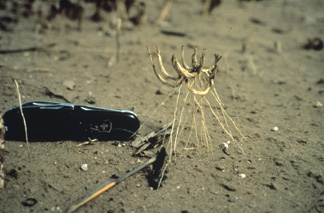'Slow, insidious' soil erosion threatens human health and welfare as well as the environment, Cornell study asserts
By Susan S. Lang

Around the world, soil is being swept and washed away 10 to 40 times faster than it is being replenished, destroying cropland the size of Indiana every year, reports a new Cornell University study.
Yet the need for food and other agricultural products continues to soar.
Plenty of people should be, stressed Pimentel, whose study on the food and environmental threat of soil erosion is published in a recent issue of the Journal of the Environment, Development and Sustainability (Vol. 8, 2006)."Soil erosion is second only to population growth as the biggest environmental problem the world faces," said David Pimentel, professor of ecology at Cornell. "Yet, the problem, which is growing ever more critical, is being ignored because who gets excited about dirt?"
"Erosion is a slow and insidious process," stressed Pimentel. "Yet, controlling soil erosion is really quite simple: The soil can be protected with cover crops when the land is not being used to grow crops."
Other ways to reduce erosion include reducing the need for people in developing countries to clear forests for agriculture, overgraze their cattle and remove crop residues for cooking fuel.
The vast majority -- 99.7 percent -- of human food comes from cropland, which is shrinking by more than 10 million hectares (almost 37,000 square miles) a year due to soil erosion, Pimentel reports, while more people than ever -- more than 3.7 billion people -- are malnourished.
"Erosion is one of those problems that nickels and dimes you to death: One rainstorm can wash away 1 mm (.04 inches) of dirt. It doesn't sound like much, but when you consider a hectare (2.5 acres), it would take 13 tons of topsoil -- or 20 years if left to natural processes -- to replace that loss," Pimentel said. "And that kind of loss occurs year after year by wind and rain around the world."
The study, which pulls together statistics on soil erosion from more than 125 sources, reports:
- The United States is losing soil 10 times faster -- and China and India are losing soil 30 to 40 times faster -- than the natural replenishment rate.
- The economic impact of soil erosion in the United States costs the nation about $37.6 billion each year in productivity losses. Damage from soil erosion worldwide is estimated to be $400 billion per year.
- As a result of erosion over the past 40 years, 30 percent of the world's arable land has become unproductive.
- About 60 percent of soil that is washed away ends up in rivers, streams and lakes, making waterways more prone to flooding and to contamination from soil's fertilizers and pesticides.
- Soil erosion also reduces the ability of soil to store water and support plant growth, thereby reducing its ability to support biodiversity.
- Erosion promotes critical losses of water, nutrients, soil organic matter and soil biota, harming forests, rangeland and natural ecosystems.
- Erosion increases the amount of dust carried by wind, which not only acts as an abrasive and air pollutant but also carries about 20 human infectious disease organisms, including anthrax and tuberculosis.
Media Contact
Get Cornell news delivered right to your inbox.
Subscribe